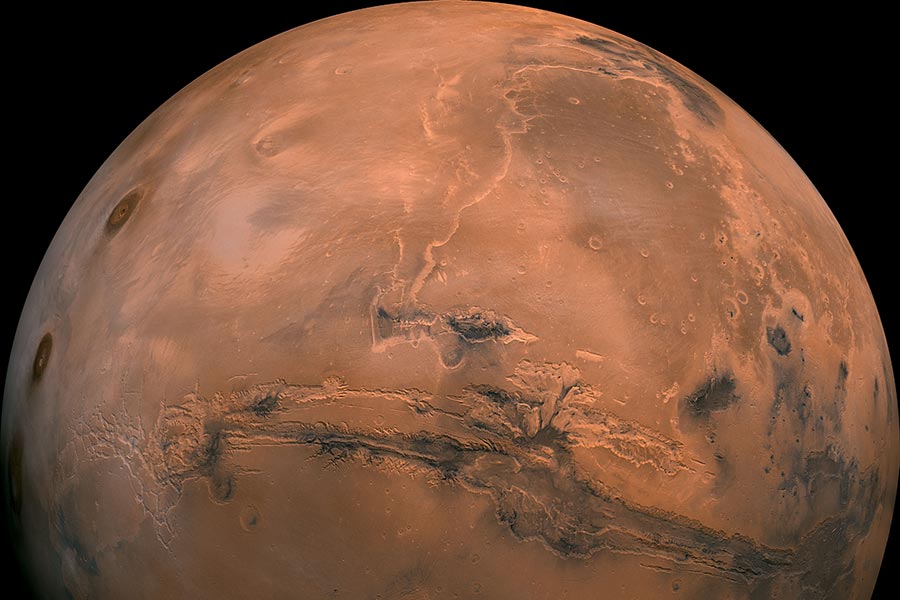Scientists discover new evidence of liquid water on Mars
10/07/2022 / By Kevin Hughes

Scientists have found new evidence indicating there could be liquid water on Mars, which is a major breakthrough in the search for life there.
The University of Cambridge-led study provided the first independent evidence that uses data aside from radar that there is liquid water beneath the south polar ice cap of the Red Planet.
“This study gives the best indication yet that there is liquid water on Mars today because it means that two of the key pieces of evidence we would look for when searching for subglacial lakes on Earth have now been found on Mars,” said Dr. Frances Butcher, second author of the study from the University of Sheffield.
“Liquid water is an essential ingredient for life, although it does not necessarily mean that life exists on Mars. In order to be liquid at such cold temperatures, the water beneath the south pole might need to be really salty, which would make it difficult for any microbial life to inhabit it. However, it does give hope that there were more habitable environments in the past when the climate was less unforgiving,” Butcher added.
The international research team, which also involved scientists from the University of Nantes and University College Dublin, used spacecraft laser-altimeter measurements of the shape of the upper surface of the ice cap to identify subtle patterns in its height.
The researchers then showed that these patterns match computer model predictions for how a body of water below the ice cap would affect the surface. Mars, just like Earth, has deep water ice caps at both of its poles, which are almost equal in combined volume to the Greenland ice sheet.
But unlike Earth’s ice sheets, which have huge subglacial lakes and water channels beneath them, Mars’ polar ice caps Mars’ polar ice caps are likely frozen solid all the way to their bedrock because of frigid climate.
Temperatures on Mars is about -81 degrees Fahrenheit on average and can drop as low as -220 degrees Fahrenheit in winter at the poles.
Study findings support radar measurements suggesting presence of water beneath the ice on Mars
The researchers’ findings, published on September 29 in the journal Nature Astronomy, agree with previous ice-penetrating radar measurements suggesting a potential area of liquid water beneath the ice.
“The combination of the new topographic evidence, our computer model results and the radar data make it much more likely that at least one area of subglacial liquid water exists on Mars today, and that Mars must still be geothermally active in order to keep the water beneath the ice cap liquid,” said research head Neil Arnold of Cambridge’s Scott Polar Research Institute.
The team used a broad range of techniques to analyze data from the Mars Global Surveyor of the National Aeronautics and Space Administration. The satellite focuses on the surface terrain of Mars’ south polar ice cap where the radar signal was detected.
The study showed 10- to 15-kilometer-long surface undulations comprising a depression and a corresponding raised area, both of which deviate from the surrounding ice surface by several meters. This is similar in scale to undulations over subglacial lakes on Earth.
Scientists then tested if the undulations on the ice’s surface could be explained by liquid water at the bed. They then ran computer simulations of ice flow that were adapted to the specific conditions of Mars.
Next, they inserted a patch of reduced bed friction in the simulated ice sheet bed where water, if present, would allow the ice to slide and speed up. Their experiments generated undulations on the simulated ice surface that are similar in size and shape to those the team observed on the real ice cap surface.
The similarity between the undulations produced by computer model and the actual spacecraft observations suggest that there’s an accumulation of liquid water underneath Mars’ south polar ice cap.
“The quality of data coming back from Mars, from orbital satellites as well as from the landers, is such that we can use it to answer really difficult questions about conditions on and even under the planet’s surface, using the same techniques we also use on Earth. It’s exciting to use these techniques to find out things about planets other than our own,” said Arnold.
Follow Space.news for more stories like this.
Watch this video about the water discovery that proves there is life on Mars.
This video is from the Health Ranger Report channel on Brighteon.com.
More related stories:
Study shows gullies on Mars’ southern hemisphere.
Glaciers on Mars could help astronauts survive on the planet.
Astronomers may have discovered multiple underground lakes on Mars.
Sources include:
Submit a correction >>
Tagged Under:
breakthrough, discoveries, Earth, geothermal heating, Greenland ice sheet, landers, Life on Mars, liquid water, Mars, Mars Global Surveyor, NASA, orbital satellites, polar ice caps, radar data, red planet, undulation
This article may contain statements that reflect the opinion of the author
RECENT NEWS & ARTICLES
Cosmic.News is a fact-based public education website published by Cosmic News Features, LLC.
All content copyright © 2018 by Cosmic News Features, LLC.
Contact Us with Tips or Corrections
All trademarks, registered trademarks and servicemarks mentioned on this site are the property of their respective owners.




















